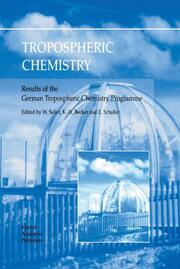Detailansicht
Tropospheric Chemistry
Results of the German Tropospheric Chemistry Programme
ISBN/EAN: 9789401039215
Umbreit-Nr.: 4371342
Sprache:
Englisch
Umfang: vii, 492 S., 61 s/w Illustr., 30 farbige Illustr.
Format in cm:
Einband:
kartoniertes Buch
Erschienen am 13.09.2012
Auflage: 1/2012
- Zusatztext
- which successfully passed the QA-process (i.e., met the Data Quality Objectices) were included into the TFS-central data bank. The following summary of major results obtained in TFS would not have been possible without the contribution of many experimentalists and modellers participating in this project. I would like to thank these colleagues for their support. All participants are grateful for the financial support by the BMBF and for the assistance by the Projekttragerschaft (UKF-GSF-Miinchen). Garmisch-Partenkirchen, WOLFGANG SEILER February 2002 DEVELOPMENT AND APPLICATION OF A MESOSCALE MODEL HIERARCHY FOR THE DIAGNOSIS AND FORECAST OF THE DISTRIBUTION OF POLLUTANTS OVER GERMANY AND EUROPE Journal of Atmospheric Chemistry 42: 5-22, 2002. 5 © 2002 Kluwer Academic Publishers. An Empirical, Receptor-Based Procedure for Assessing the Effect of Different Ozone Mitigation Strategies WOLFGANG FRICKE, WINFRIED VANDERSEE and STEFAN GILGE Deutscher Wetterdienst, Meteorologisches Observatorium, Albin-Schwaiger-Weg 10, D-82383 Hohenpeissenberg, Germany, e-mail: wolfgang.fricke@dwd.de (Received: 6 November 2000; in final form: 29 May 2(01) Abstract. The paper presents a new receptor-based approach for investigating the effect of differ ent mitigation strategies on surface ozone concentrations. The empirical approach relates measured ozone concentrations to 3-D back trajectories and European precursor emission data (NOx, VOC, isoprene). These are the only parameters used as input. Following a description of the method, results for two German stations, an urban and a rural mountain site, are described, and discussed in detail.
- Autorenportrait
- InhaltsangabePreface; W. Seiler. Development and Application of a Mesoscale Model Hierarchy fir the Diagnosis and Forecast of the Distribution of Pollutants over Germany and Europe. Receptor-Based Procedure for Assessing the Effect of Different Ozone Mitigation Strategies; W. Fricke, et al. Short-Term Ozone Forecasting with a Network Model System During Summer 1999; H.J. Jakobs, et al. Studying the City Plume of Berlin on 20 July 1998 with Three Different Modelling Approaches; A. Becker, et al. On the Importance of Reliable Background Concentrations of Ozone for Regional Scale Photochemical Modelling; B. Langmann, S.E. Bauer. Comparison of Five Eulerian Air Pollution Forecast Systems for the Summer of 1999 Using the German Ozone Monitoring Data; S. Tilmes, et al. On Modeling Dry Deposition of Long-Lived and Chemically Reactive Species over Heterogeneous Terrain; G. Tetzlaff, et al. Anthropogenic and biogenic emissions as well as deposition of trace gas constituents. Emission of Biogenic Volatile Organic Compounds: An Overview of Field, Laboratory and Modelling Studies Performed during the `Tropospheric Research Program' (TFS) 1997-2000; J.-P. Schnitzler, et al. Development of Emission Models and Improvement of Emission Data for Germany; R. Friedrich, et al. Evaluation of Modeled Spatially and Temporarily Highly Resolved Emission Inventories of Photosmog Precursors for the City of Augsburg: The Experiment EVA and Its Major Results; F. Slemr, et al. Quality Assurance in TFS for Inorganic Compounds; H.-J. Kanter, et al. Quality Assurance of Hydrocarbon Measurements for the German Trophospheric Research Focus (TFS); A. Volz-Thomas, et al. A Database for Volatile Organic Compounds; K. Mannschreck, et al. Process studies on the formation of oxidants and oxidation capacity. Ozone and PAN Formation Inside and Outside of the Berlin Plume &endash; Process Analysis and Numerical Process Simulation; U. Corsmeier, et al. Chemical Mechanism Development: Laboratory Studies and Model Applications; H. Geiger, et al. Free Radicals and Fast Photochemistry during BERLIOZ; U. Platt, et al. Verification of the Contribution of Vehicular Traffic to the Total NMVOC Emissions in Germany and the Importance of the NO3 Chemistry in the City Air; R. Kurtenbach, et al. Actinic Radiation and Photolysis Processes in the Lower Troposphere: Effect of Clouds and Aerosols; W. Junkermann, et al. Hydrogen Peroxide, Organic Peroxides and Higher Carbonyl Compounds Determined during the BERLIOZ Campaign; G.K. Moorgat, et al. Ground-Based and Airborne Measurements of Nonmethane Hydrocarbons in BERLIOZ: Analysis and Selected Results; J. Winkler, et al.
